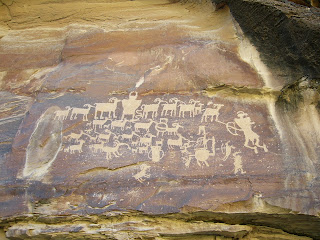 |
| Chuck, setting up our tent |
 |
| Staying warm by the fire |
 |
| By the fire with Jerry and Donna |
On the first day, we drove to the part of the Canyon Jerry wanted to work on and split into teams. He had been there earlier and found some sites down low near the creek bottom. Those needed to be recorded; and he wanted our team to climb high up the canyon walls, searching for more sites. No trails. We just scrambled up the sides of the canyon, like what you can see behind Chuck in this picture, fanned out, and started picking our way up and along each cliff band, searching for arrow heads, pottery shards, rocks that looked as if they had been deliberately stacked, rocks buried perpendicular in the ground, or rock art.
We climbed higher and higher...
...and explored our assigned side of the canyon carefully, but found nothing. Finally, Jerry radioed and asked us to come back down to work on recording some sites that had been found earlier.
Nothing that needed to be recorded was spectacular. Let me show you an example of spectacular rock art, for example.
 |
| The Great Hunt |
The team found this. NOT spectacular, but it still needed to be recorded.
What you can't see is that, on the little slab to the right of the petroglyph is the scratched graffiti of a guy named Cecil from Vernal, who found this spot in 1961. There is graffiti in the canyon from the 1800s up through the 60s or so. People mostly know better now. Mostly. The graffiti gets recorded, too.
We also recorded this, which is a piece of wall...
...as is this slightly better specimen.
I knew nothing about recording sites, but they showed me what to do. You have to sketch what you see, map its location, measure everything, fill out forms and create a description narrative.
It was fun, and a beautiful day, despite the cold.
As we looked across to the other side of the canyon though, we were very excited to see a really big structure in the cliff face. It was visible from the road, if you know what to look for; so we were pretty sure that someone must have visited it before. But it had never been recorded, so Jerry was excited. You cannot see the structure in this picture. It was too hard to see for me to get a good picture. And I was sure that I would get a chance to take great close up photos the next day when we climbed up to it. We were a little unsure of HOW, though.
This is NOT the structure I am describing. This is just an example, so you get an idea of what we saw high up in the cliff face. It was a structure like these. Only five of us went over to try to access the structure the next day: Jerry, Donna, Chuck, me and another guy. The remaining volunteers went to climb a butte that had the remains of an entire village on its top. Our group started bush-whacking our way across the creek bottom. We bridged the creek by tossing logs across until we had something stable enough to walk on, then made our way to the cliff face. The others went up; but I didn't, and I was so sad! First, I needed to stand below and out a little way from the cliff so I could call out directions to Chuck, who is a really good climber, as to where it looked like he could find hand and foot holds. Then Jerry, Donna and the other guy had a go, and managed with great difficulty. Jerry's wife needed to be boosted from below and pulled from above to get up trickiest part of the 20 foot cliff-band, after which here was a bunch more scrambling that sent rocks plummeting noisily down. They all made it eventually, but I was still down below and knew I was going to need a boost like Donna did, if I was going to get up there. I was bummed to be left behind and had a little sniffle while I waited below for them to do all the recording. However, I stopped regretting it when I saw them trying to descend. Even Chuck had a hard time. The other three really struggled and Jerry's wife panicked at the tricky part. .Why is going down always so much harder than going up?
That was all we had time for this weekend. But maybe we will get to go along again next year. There is still a lot out there, waiting to be found.













Reading this was the best part of my day.
ReplyDeleteThanks!
I passed this on to Liv's Father who is a geologist. He studies rocks, of course, but absolutely LOVES this sort of thing. Me? I would like it if I could leave at the end of the day to go to a five star hotel and see a mint on my pillow. I am SO not the camper. And that lovely bird!
ReplyDelete